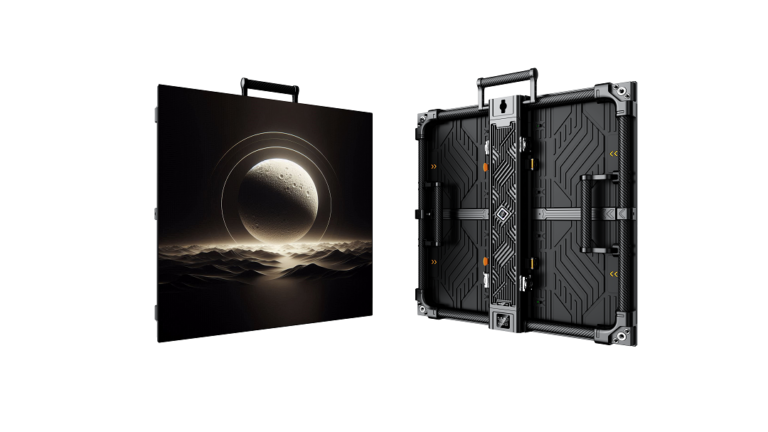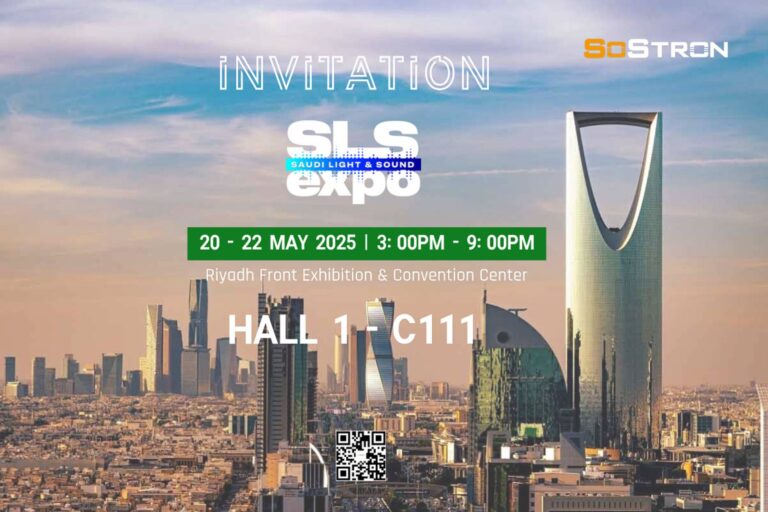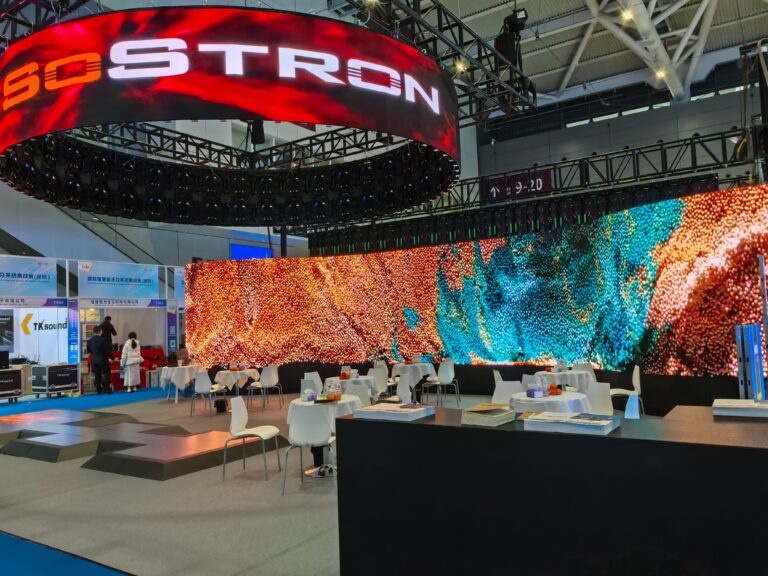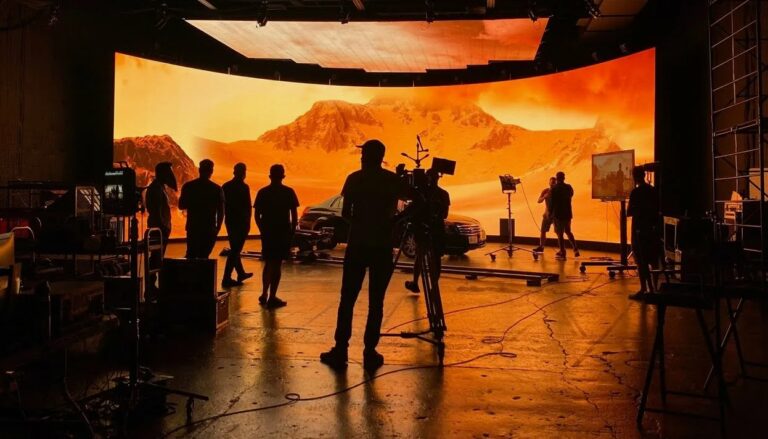Table of Contents
- What is a Cube LED Display?
- What are the Applications of Cube LED Displays?
- How to Install a Cube LED Display?
- What is the Cost of a Cube LED Display?
- Is the Maintenance of a Cube LED Display Difficult?
- How Does a Cube LED Display Differ from a Traditional Flat LED Display?
1. What is a Cube LED Display?
A Cube LED Display is a unique display device made up of multiple LED modules or pixels that form a three-dimensional (3D) cube shape. Each LED module is a light-emitting unit, and by controlling the brightness and color of each LED, rich images and videos can be displayed. The distinct feature of the Cube LED Display is its shape and structure, offering display capabilities from multiple directions. Each side of the cube is a square, allowing it to show content from various angles, making it ideal for 3D advertising, exhibitions, indoor decor, and other applications.
Cube LED Displays are typically designed with multiple panels, with each panel functioning as an independent display unit that can show different content. This design enhances the visual impact and increases audience interaction and immersion.
2. What are the Applications of Cube LED Displays?
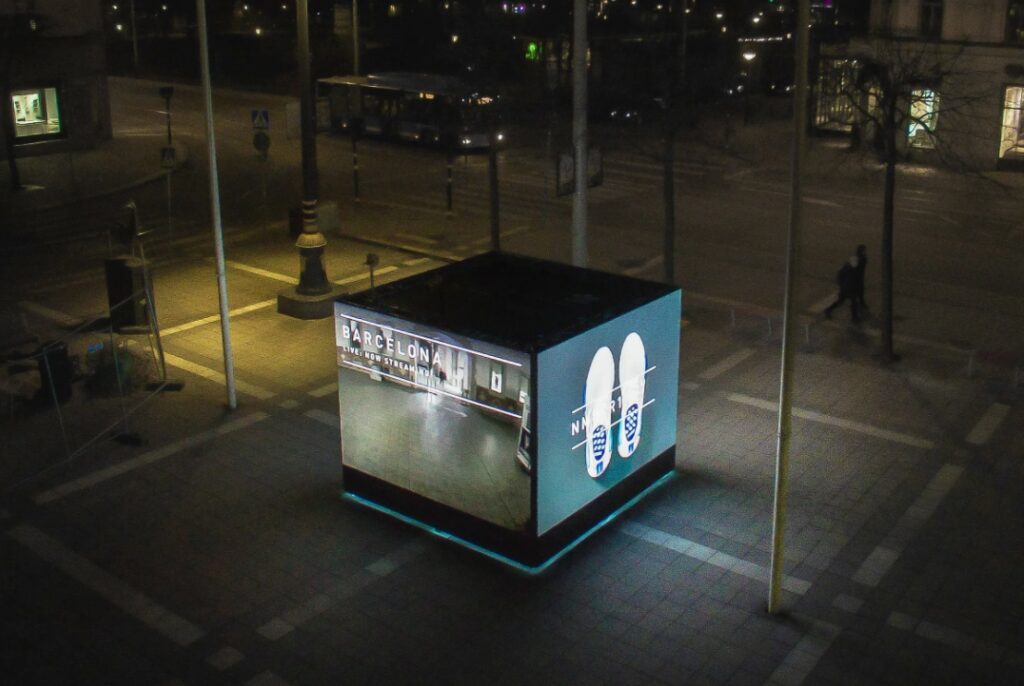
- Commercial Advertising: Cube LED Displays are commonly used in shopping malls, plazas, and stations for advertising. Their unique 3D display effect allows them to catch the viewer’s attention from multiple angles, enhancing brand visibility and advertising effectiveness. For example, many shopping centers use Cube LED Displays at their main entrances to showcase ads and promotions.
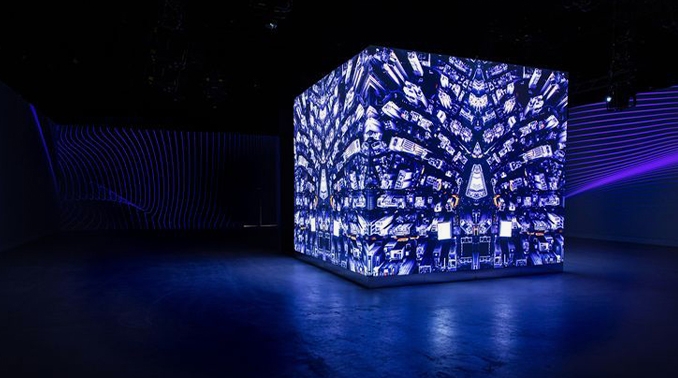
- Exhibitions and Trade Shows: In large exhibitions, Cube LED Displays provide a more dynamic and interactive experience. They can display more information in a limited space and attract viewers’ attention with their 3D effects, enhancing booth attractiveness.
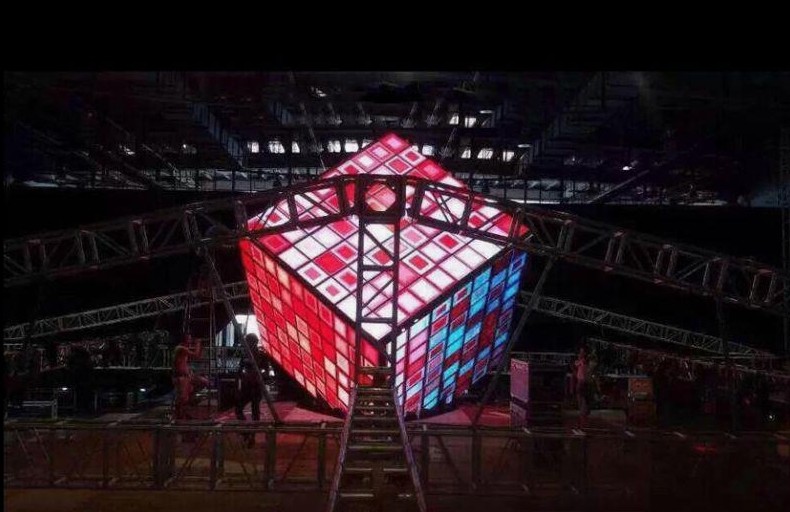
- Stages and Performances: Cube LED Displays are widely used in large concerts, stage plays, and events, especially where strong visual impact and creative displays are needed. For example, international music festivals and New Year’s Eve parties often use Cube LED Displays to elevate stage effects and enhance the live audience experience.
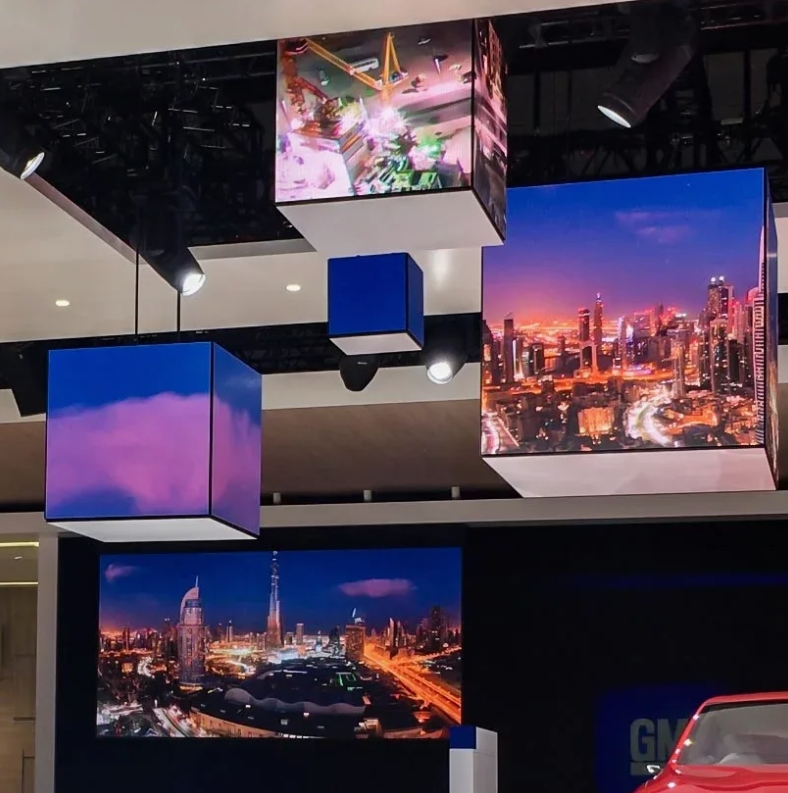
- Public Information Displays: Cube LED Displays are also useful in public information displays, such as cityscape presentations and traffic management information. For example, Cube LED Displays are commonly used at major city intersections to display weather forecasts and traffic updates.
- Retail Window Displays: The retail industry also benefits from Cube LED Displays for product presentation. High-end brands use Cube LED Displays to showcase their latest product lines, enhancing the consumer shopping experience.
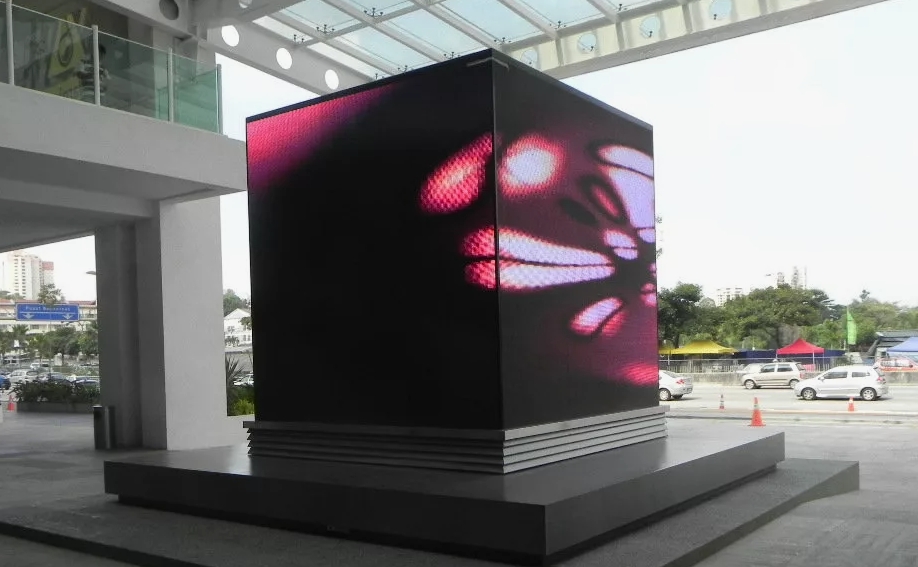
Example 1: Cube LED Display at the Shanghai World Financial Center
As one of China’s top commercial landmarks, the Shanghai World Financial Center installed a massive Cube LED Display in its atrium. The display showcased a variety of advertisements and dynamic content, capturing the attention of visitors and customers. Each side of the Cube LED Display could independently show different content, enhancing both visual impact and interactivity. Visitors and customers could view different images from various angles, greatly enhancing brand display and commercial value.
This example demonstrates that Cube LED Displays in commercial buildings can offer a unique visual experience while significantly boosting brand exposure.
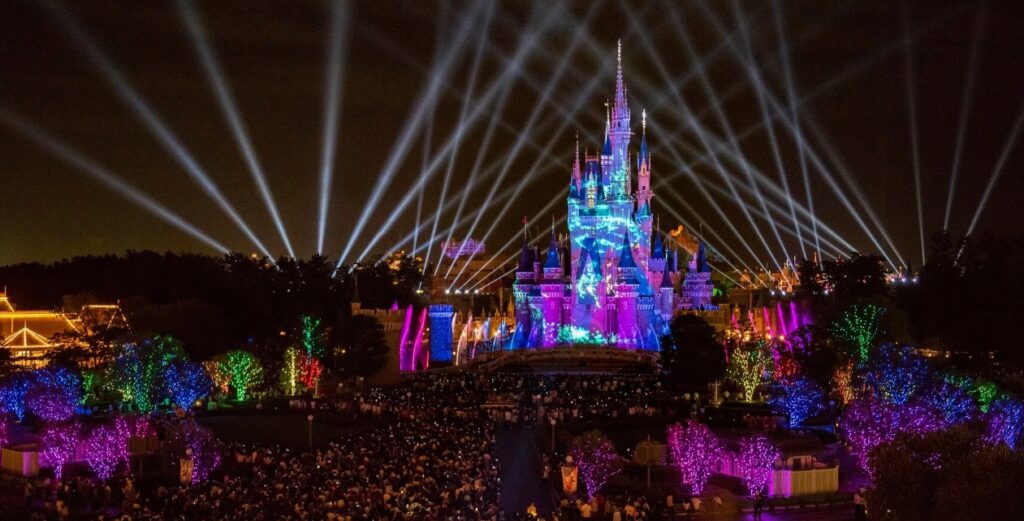
Example 2: Cube LED Display at Disneyland
In large events at Disneyland, Cube LED Displays are also widely used. For example, during the Star Wars themed events, multiple Cube LED Displays were installed to show dynamic 3D video effects and interactive content. The cube shape allowed the displays to show different images from different angles, ensuring that visitors had an optimal viewing experience regardless of their location.
This case shows how Cube LED Displays enhance interactivity and deepen the immersive experience for visitors, helping to increase attendance and improve entertainment and engagement.
3. How to Install a Cube LED Display?
The installation of a Cube LED Display involves several steps. Below is a general installation process:
- Select an Appropriate Installation Location: Choose a location with sufficient space and adequate power supply. The viewing distance, angles, and lighting conditions must be taken into account when selecting the site.
- Prepare the Infrastructure: Check the stability of the wall or frame to ensure they can support the display’s weight. The frame must be capable of withstanding the weight of the cube and supporting the installation at different angles.
- Install the Frame: Based on the display’s structural design, install the frame or suspension system. The frame should match the size and weight of the display and provide firm support.
- Install the Display Modules: Attach the LED modules one by one to the frame and connect them. Since each side of the Cube LED Display is made up of several modules, careful attention should be given to aligning the seams between modules.
- Connect the Power and Signal Lines: After installing the modules, connect the power and signal cables. These connections should adhere to safety standards to avoid electrical faults or overloads.
- System Debugging and Calibration: Once installed, perform system debugging to check the display’s performance and color contrast. Ensure that all modules are functioning properly and display the best results. Here are 7 major guidelines for LED cube.
4. What is the Cost of a Cube LED Display?
The cost of a Cube LED Display is typically high, with several factors affecting its price:
- Screen Size and Number of Panels: The price of the Cube LED Display depends on its size and number of panels. Generally, the more panels and larger the display, the higher the cost.
- Resolution and Technical Specifications: The higher the resolution of the LED screen, the finer the display effect, and the higher the cost. High-resolution displays are suited for detailed presentations. Common resolutions include P3, P4, P5, etc.
- Customization: If the display requires custom shapes, colors, sizes, or installation methods, this will increase the cost.
- Brand and Supplier: Different brands and suppliers have different pricing strategies. High-end brands typically offer better quality products but at higher prices.
4.1 Cube LED Display Cost Estimate
4.1.1 Screen Size and Number of Panels
The price of Cube LED Displays is closely related to its size and the number of panels:
- Small Cube LED Displays (e.g., 3 sides, each side is smaller): Around $7,000 to $14,000.
- Medium Cube LED Displays (e.g., 4 or more sides, medium size): Around $14,000 to $28,000.
- Large Cube LED Displays (e.g., 6 or more sides, larger size): From $28,000 to $70,000 or more.
4.1.2 Resolution
Higher resolution displays provide finer details, but the cost increases accordingly. Common resolutions are P2.5, P3, P4, etc.:
- Low Resolution (e.g., P4, P5): Suitable for viewing from a distance, priced lower.
- High Resolution (e.g., P2.5, P3): Used for finer detail, priced higher.
High-resolution screens can increase the cost by 10%-30%.
4.1.3 Custom Design
Customization of shape, size, or color significantly raises the cost, generally adding 20%-40% to the price.
4.1.4 Brand and Supplier
Different brands have varying prices:
- High-End Brands (e.g., Samsung, LG): $850 to $1,700 per square meter.
- Mid-Range Brands: $600 to $1,200 per square meter.
- Low-End Brands: Around $400 per square meter.
4.1.5 Installation and Transportation
Installation and transportation costs are additional:
- Installation Costs: Typically range from $2,000 to $7,000, depending on complexity.
- Transportation Costs: Due to the size, transportation costs can account for 5%-10% of the total cost, around $500 to $3,000.
4.1.6 Software and Control System
A Cube LED Display requires a specific software and control system:
- Software and Control System Costs: Around $1,500 to $7,000, depending on the system’s capabilities and complexity.
4.1.7 Maintenance Costs
The maintenance costs vary based on usage frequency and the number of repairs required:
- Routine Maintenance: Approximately $300 to $700 per year.
- Repairs and Replacement Parts: Repairing a damaged LED module or other parts can cost between $150 and $700.
4.1.8 Total Estimate
For a 4-sided Cube LED Display with each side measuring 2m x 2m, resolution of P3, and mid-range brand:
- Display Cost: Approximately $8,000.
- Installation Cost: $3,000.
- Software Control System: $2,000.
- Transportation Cost: $700.
- Maintenance Cost: $400 per year.
Total estimated cost: $13,000 to $15,000.
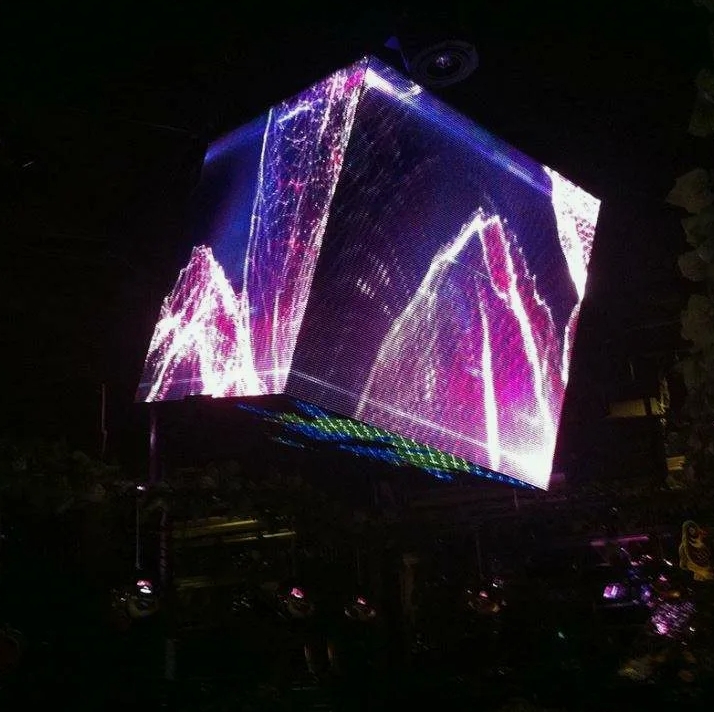
5. Is the Maintenance of a Cube LED Display Difficult?
The maintenance of a Cube LED Display is generally more complex than traditional flat LED displays. Due to its multi-sided structure, problems with one side may affect the entire display’s performance. Therefore, regular maintenance and inspection are crucial.
- Troubleshooting: Common issues include power supply problems, signal transmission errors, and damaged modules. Diagnosing issues may take more time due to the number of modules.
- Cleaning and Maintenance: The Cube’s unique shape requires careful cleaning to avoid damaging the modules or circuits. Regular cleaning helps maintain brightness and display quality.
- Software and Hardware Maintenance: Software upgrades and hardware replacements are also part of routine maintenance. Damaged modules should be detected and replaced promptly to avoid degrading the display.
- Professional Support: Given the complexity of installation and maintenance, professional technicians should handle repairs and upgrades.
6. How Does a Cube LED Display Differ from a Traditional Flat LED Display?
- Shape and Design: Cube LED Displays offer 3D visual effects, whereas flat LED displays are two-dimensional.
- Viewing Angles: Cube LED Displays provide multiple viewing angles, which are great for attracting attention from different perspectives. Flat LED screens, on the other hand, are typically designed for one viewing angle.
- Applications: Cube LED Displays are more suited for artistic, attention-grabbing applications, while flat LED displays are more commonly used in signage, billboards, and video walls.
- Cost: Cube LED Displays are generally more expensive due to their 3D structure and additional installation complexity.
Conclusion
The Cube LED Display is a display technology that offers unique visual effects and is widely used in advertising, exhibitions, stages, and other scenarios. Although its installation and maintenance are relatively complex and its cost is higher, the 3D display effect provides significant advantages in visual impact and audience interaction. With the development of technology, the application prospects of Cube LED Displays are vast, making them worthy of attention and investment across various industries.
References
LED Display Technology and Applications. Beijing: Electronics Industry Press.
“Development and Applications of LED Cube Displays.” Journal of Display Technology, 17(8), 504-510.

